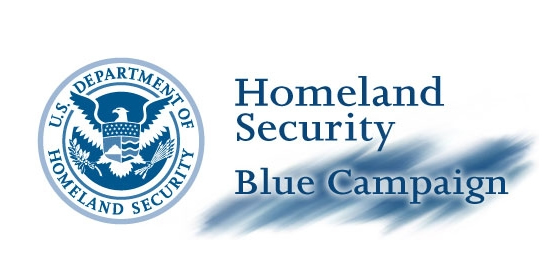The Department of Homeland Security has launched the Blue Campaign, our unified effort to combat human trafficking. According to the State Department’s 2010 Trafficking in Persons Report, more than 12 million adults and children are subject to forced labor, bonded labor, and forced prostitution around the world. And the United States is not immune to this global problem.
With annual trade exceeding $30 billion worldwide, trafficking continues to attract criminals to this market for human lives. Eradicating this horrible crime requires a concerted effort by governments, law enforcement, non-governmental organizations, and the private sector.
This is why DHS is bringing agencies together to coordinate our resources and expertise in launching the Blue Campaign. The name is a reference to the “Blue Heart” (United Nations Office on Drugs and Crime) and the “Blue Blindfold” (United Kingdom Human Trafficking Centre), as well as the “thin blue line” of law enforcement. Components from across the Department – led by ICE, CBP, USCIS, and FLETC – will participate in the campaign and work together as part of a unified DHS effort.
The elements of the Blue Campaign are organized around the “3 Ps” of the Trafficking Victims Protection Act (TVPA) of 2000: protecting victims of human trafficking through rescue, referral, and immigration relief; preventing human trafficking through targeted public outreach and education; and contributing to human trafficking prosecutions through law enforcement investigations. The Blue Campaign also emphasizes a fourth P: partnering creatively to aggressively fight trafficking in persons.
The launch of the Blue Campaign coincides with the 10-year anniversary this year of the Trafficking Victims Protection Act and its international counterpart, the United Nations Protocol to Prevent, Suppress, and Punish Trafficking in Persons, Especially Women Children. During the last decade, we’ve made significant strides in spreading awareness about human trafficking and enhancing our tools to investigate and prosecute traffickers.
During the next decade, we need to do more, which the Blue Campaign will help us achieve. To learn more about the Blue Campaign and about what you can do in your community, visit the new Blue Campaign website: www.dhs.gov/humantrafficking. You can also email the DHS Human Trafficking Initiative Steering Committee at BlueCampaign@dhs.gov. As the chair of that committee, I welcome your ideas and encourage you to become involved in the effort to protect freedom, protect your country, and help end modern slavery.
Alice Chamberlayne Hill
Senior Counselor to the Secretary
With annual trade exceeding $30 billion worldwide, trafficking continues to attract criminals to this market for human lives. Eradicating this horrible crime requires a concerted effort by governments, law enforcement, non-governmental organizations, and the private sector.
This is why DHS is bringing agencies together to coordinate our resources and expertise in launching the Blue Campaign. The name is a reference to the “Blue Heart” (United Nations Office on Drugs and Crime) and the “Blue Blindfold” (United Kingdom Human Trafficking Centre), as well as the “thin blue line” of law enforcement. Components from across the Department – led by ICE, CBP, USCIS, and FLETC – will participate in the campaign and work together as part of a unified DHS effort.
The elements of the Blue Campaign are organized around the “3 Ps” of the Trafficking Victims Protection Act (TVPA) of 2000: protecting victims of human trafficking through rescue, referral, and immigration relief; preventing human trafficking through targeted public outreach and education; and contributing to human trafficking prosecutions through law enforcement investigations. The Blue Campaign also emphasizes a fourth P: partnering creatively to aggressively fight trafficking in persons.
The launch of the Blue Campaign coincides with the 10-year anniversary this year of the Trafficking Victims Protection Act and its international counterpart, the United Nations Protocol to Prevent, Suppress, and Punish Trafficking in Persons, Especially Women Children. During the last decade, we’ve made significant strides in spreading awareness about human trafficking and enhancing our tools to investigate and prosecute traffickers.
During the next decade, we need to do more, which the Blue Campaign will help us achieve. To learn more about the Blue Campaign and about what you can do in your community, visit the new Blue Campaign website: www.dhs.gov/humantrafficking. You can also email the DHS Human Trafficking Initiative Steering Committee at BlueCampaign@dhs.gov. As the chair of that committee, I welcome your ideas and encourage you to become involved in the effort to protect freedom, protect your country, and help end modern slavery.
Alice Chamberlayne Hill
Senior Counselor to the Secretary

